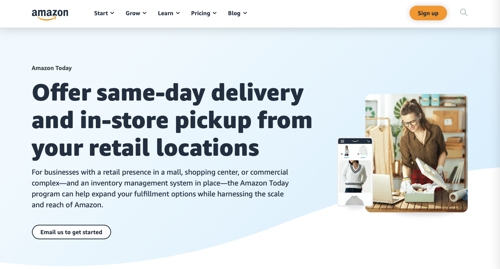If you have a business with a large reach or an international market, consider personalizing your ecommerce feeds based on location, such as by displaying items in the local currency and language. Many enterprise ecommerce platforms are customizable to suit your business’s specific needs and can handle a higher volume of clients.
If you want to improve your customers’ experience, cultivate a connection with them, and ultimately boost sales and retention, personalizing your buyers’ journey is essential.
This type of personalization is suited for existing users. When a customer is logged into their account, you will be able to deliver welcome pages that highlight offers and items most likely to be of interest to that individual.
If this was a brick-and-mortar store, the personalized recommendation portion would essentially be the employee that assists a customer in the changing room. They may not have loved that item, but what about this? Or, if you loved this item, here’s one just like it!
What to consider before personalizing your ecommerce strategy
In addition, by delivering highly relevant content, you can avoid wasting time and money on marketing material they are not interested in.
- A way to collect data on users. This includes behavioral, demographic, and transactional data you collect through loyalty programs and cookies (but hopefully, first-party data).
- A way to analyze the collected data. From there, you can aggregate pools of visitors for specific marketing campaigns.
- A way to deliver an experience to each segment effectively.
How to personalize your customers’ ecommerce journey
Your customers’ needs and interests vary, so why offer them the same products? This type of personalization requires the collection of data on how users interact with your website. Using that data, you can then employ behavioral segmentation to create special campaigns for specific groups within your customer base
1. Create personalized homepages
This personalization can also be directed regionally. For example, if you run an online clothing store, you will have different items based on the season. However, the winter season in California is different than that of Michigan. Catering to climates and regional fashion styles can make your campaigns that much more effective.
2. Display recently viewed items
You can base these personalized recommendations on abandoned carts or on pages the user has visited. The more data you get on that user, the better recommendations you can give them.
Product recommendations account for 31% of ecommerce site revenues, according to a study by Barilliance. This means that its cost-benefit potential for your business is impossible to ignore.
Now that we have a foundation of what ecommerce personalization is and where to start, let’s look at the different ways you can create an individualized customer journey for your users. Keep in mind that even though personalization can lead to significant payoffs in customer satisfaction and conversions, it still requires resources. Consider the feasibility of personalization within your marketing strategy. Depending on your industry and audience, some of the methods below may be easier to implement or effective than others. So aim to deliver an impactful experience that makes it worth the investment.
You can use this strategy to target both existing and new customers. For example, you can offer first-time visitors an incentive to sign up for an email list or loyalty program. If an existing customer has recently received items from your company, you can ask them to leave a review.
3. Cater your offerings to location
Sending these types of emails is beneficial for all types of ecommerce businesses. However, it may be a good way for DTC businesses to compete in a world that now includes businesses like Amazon. What is DTC? It stands for Direct to Consumer, and is a new way for manufacturers to eliminate the hassle of traditional distribution by delivering their products directly to consumers.
If a customer has opted in for marketing emails, you can use their behavioral data to send them offers and information targeted at their interests. They’ll be much more likely to click on your links. Just be sure to include personalization in your subject lines too—you’ve got to get them to open the email first!
4. Develop special campaigns based on user behavior
What is IaaS? It is Infrastructure as a Service, a type of online computing infrastructure. IaaS delivers computing resources over the internet and can be scaled and financed according to demand. Servers, hardware, virtualization, and cloud storage are all handled through your IaaS product.
Personalization programs can yield 20% higher customer satisfaction rates and a 10-15% increase in sales conversion rates.
In the world today, there are 3.9 billion daily email users. That gives businesses an excellent opportunity to connect with their audience, but with so many users comes high competition. So how can you stand out in your subscribers’ inboxes? Personalization.
When your team and your customers feel engaged with each other through communication and personalization, you will not only have higher employee and customer satisfaction, but you will also see higher returns. Now go out and start personalizing your customers’ journeys.
- What is the user clicking on?
- What pages do they frequently visit?
- What is in their cart or on their wish list?
- What category of products do they show particular interest in?
- How long has it been since their last purchase?
5. Personalize your emails
As a customer interacts with your website over a period of time, you can offer them more personalized offers based on their interests. Some things to consider when developing personalized campaigns are:
Users may browse your ecommerce site multiple times before placing items of interest in their carts. Allowing them to see items they’ve already clicked on provides that nudge to resume their browsing.
Keeping data on recently viewed items requires aggregating customer data. If you do not want to spend the time and money on the infrastructure to protect and carry out the storage and utilization of this data, consider investing in an IaaS offering.
6. Make product recommendations
Sunny Dhami is the Senior Director, EMEA Product Marketing & GTM for RingCentral. He has extensive marketing experience across SaaS, telecommunications, and technology sectors within companies such as Vodafone, Reed Elsevier, Calor Gas, and SapientNitro.
Talk with your team about the best ways to personalize your ecommerce site and offerings. Even if your team is working from home, consider using video conferencing software or VoIP solutions available to you.
If your online store has a substantial number of products, a customer may lose interest before they find the product they love. Personalized recommendations act as a guide for your customers within your website.
As people have adapted to an uptick in at-home working, online engagement has surged. In 2020, retail ecommerce sales grew 27.6% year over year, which totals .3 trillion. This opens up opportunities for ecommerce businesses but also presents the challenge of standing out.
Start personalizing your customers’ ecommerce buyer journey today
Recently viewed items can be located on the homepage or a landing page linked to from a marketing email. However, they can also be located at the bottom of all the pages in your ecommerce store. This allows customers to keep track of all the items in which they were interested enough to click on.
Personalization is a vital component of a successful ecommerce marketing strategy. You want customers to have the same experience they would get at a brick-and-mortar store, from the comfort of their own home.
Reviews are vital to any business’s success. In fact, if a product gets just five reviews, its likelihood of being purchased increases by 270%.
About the author
Before you start deploying ecommerce personalization strategies, there are important things you need to consider. You need:





